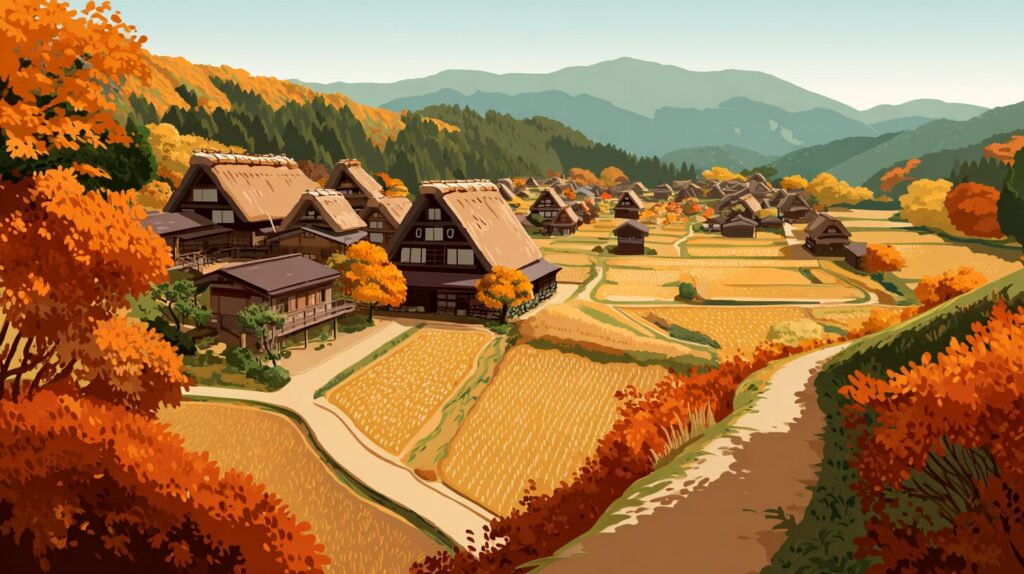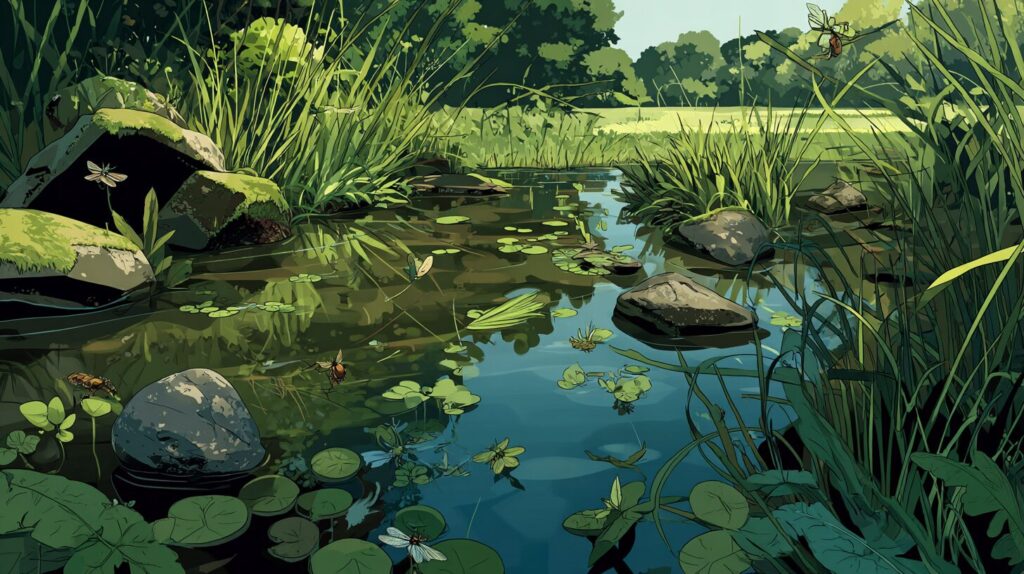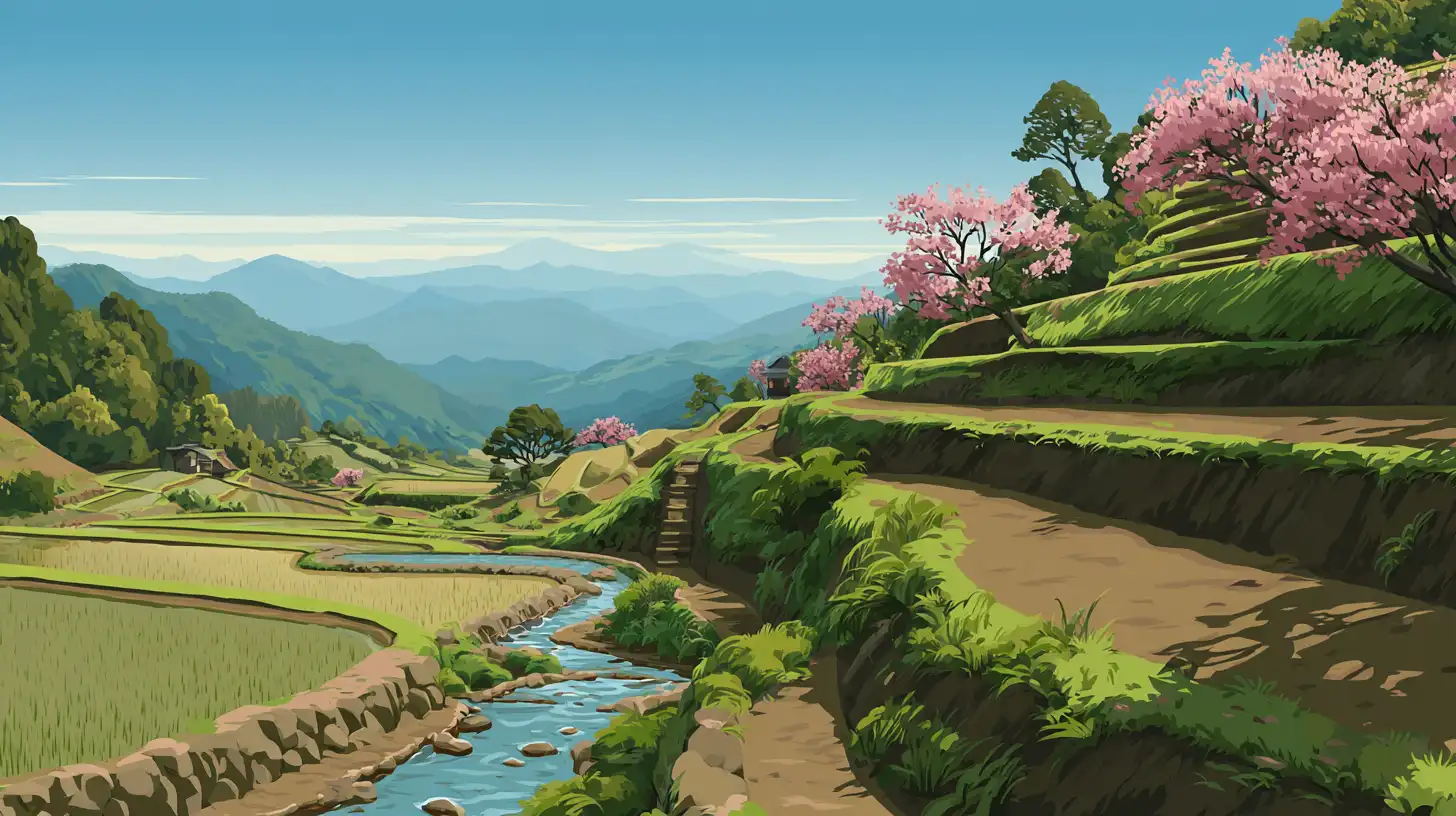里山を英語で説明・紹介するための基本情報と、英会話に役立つ表現をシンプルでわかりやすい英語で紹介します。
英会話ダイアローグ・概要・10の質問を通して、里山に関する英語表現を学びます。
英語
英会話ダイアローグを読む前に知っておくと良い前提知識と情報です。
- 里山とは
- 人々の生活圏(里)と自然の山(山)の間に広がる地域で、日本独自の文化や景観
- 田んぼや畑、雑木林、池、小川など、さまざまな環境が組み合わさっている
- 里山の特徴と魅力
- 多様な生き物が生息し、四季折々の美しい景色が楽しめる
- 昔ながらの農作業や山菜採り、炭焼き、祭りなど、日本の伝統的な生活や文化が今も残る
- 都会では味わえない、自然と人が共生する空間
- 里山体験とは
- 田植えや稲刈り、野菜の収穫、山菜・キノコ採りなど、農業・自然体験ができる活動
- 近年は環境教育や癒し、レクリエーションの場としても注目され、多くの人が参加している
- 有名な里山地域
- 里山の保全活動
- 都市化により一度衰退した里山だが、近年その価値が見直されている
- 市民参加による保全活動、農業体験プログラム、エコツーリズムなどが盛んになっている
2人が里山について話しています。
伝統的な里山の概要や特徴、豊かな生物多様性、四季折々の美しい風景、里山体験などを話題にしています。
会話 / dialogue

Hey Key, have you ever heard of satoyama? I’ve been reading about it lately, and it sounds fascinating.

Of course! Satoyama is quite a unique part of Japanese culture. What got you interested in it?

I saw a documentary about people restoring satoyama landscapes. The idea of living close to nature but still having a community really appeals to me.

That’s exactly what makes satoyama special. It’s the space between the village and the mountain—where people have managed the land for centuries.

Right, and it’s not just wild nature, is it? People actually work the land—growing rice, managing forests, even making charcoal.

Yes, and because of that, satoyama areas are full of biodiversity. You can find many kinds of birds, insects, and rare plants there.

I read that the scenery changes a lot with the seasons too. Like, cherry blossoms in spring, green rice fields in summer, red leaves in autumn, and even snow in winter.

Exactly! That’s part of the charm. Each season brings something different, and it’s all very photogenic.

Do you know any famous satoyama areas? I’d love to visit one sometime.

Sure. There’s Musashino near Tokyo, which still has traditional woodlands. Shiga’s Omi satoyama is also famous for its rice terraces. And of course, Shirakawa-go in Gifu is a World Heritage site with amazing scenery.

Oh, Shirakawa-go! I’ve seen pictures of those thatched-roof houses surrounded by mountains and fields. It looks beautiful.

It really is. And what’s cool is that you can actually try satoyama experiences in many places now.

Like what?

You can help with rice planting or harvesting, go hiking, pick wild vegetables or bamboo shoots, try making charcoal, or even join local festivals.

That sounds incredible! I’d love to try something like harvesting rice or picking mushrooms.

You should! There are also nature walks where you can watch birds and insects, and some places let you make traditional crafts from bamboo or straw.

I bet it’s a nice break from city life in Tokyo. I’ve been feeling like I need more time in nature.

Definitely. That’s why satoyama is getting popular again. People want to relax, learn about the environment, and connect with traditional culture.

Are there many opportunities for people from the city to join satoyama activities?

Yes, lots of organizations and local groups welcome volunteers and visitors. Some even have day trips or weekend programs for city people.

It must be rewarding to help protect the environment and also learn something new.

It is. Plus, you get to meet local people and sometimes even share in traditional meals or join seasonal events.

I think I’ll look for a satoyama program for my next holiday. Maybe you could join me?

I’d love to! Let’s plan it together—I think it’ll be a great experience for both of us.
概要(里山とは?自然と暮らしが調和する日本の原風景)
「里山」について、理解を深めるための「英語での概要」です。
里山

What Is Satoyama?
Satoyama is a special type of rural area in Japan. It is the land between villages and mountains. In satoyama, you can see rice fields, vegetable gardens, forests, ponds, and small rivers. People have lived and worked in satoyama for hundreds of years. They use the land for farming, collecting firewood, and finding wild plants. Satoyama is not wild nature, but it is not a city either. It is a place where people and nature live together.
Main Features
Satoyama has many different types of landscapes. There are fields for rice and vegetables, forests with many trees, and small ponds and streams. This mix of nature is good for many animals and plants. Birds, insects, frogs, and many flowers live in satoyama. People take care of the land, so the environment stays healthy. In each season, the scenery changes. You can see cherry blossoms in spring, green rice fields in summer, colorful leaves in autumn, and snow in winter.
Satoyama Experiences
Today, satoyama is popular for many activities. People from cities visit to try rice planting, harvest vegetables, or walk in the forests. They can also join local festivals or learn to make things with bamboo or straw. Satoyama is a good place to relax and learn about traditional Japanese culture. Many schools use satoyama for nature study trips. Satoyama helps people enjoy nature, learn new things, and remember the importance of living with the environment.
10の質問(里山の基本がわかるQ&A)
「里山」について、理解を深めるための「英語での10の質問」です。
1: What is satoyama?
Satoyama is a rural area in Japan between villages and mountains. People and nature live together there.
2: What can you see in satoyama?
In satoyama, you can see rice fields, forests, vegetable gardens, ponds, and small rivers.
3: Why is satoyama important?
Satoyama is important because it helps protect many animals and plants. It also shows traditional Japanese life.
4: How do people use satoyama?
People use satoyama for farming, collecting firewood, picking wild plants, and sometimes making charcoal.
5: What kinds of animals live in satoyama?
Many birds, insects, frogs, and small animals live in satoyama. You can also find rare plants there.
6: How does satoyama change with the seasons?
Satoyama changes a lot in each season. You can see cherry blossoms in spring, green fields in summer, red leaves in autumn, and snow in winter.
7: What activities can you try in satoyama?
You can try rice planting, harvesting vegetables, hiking, picking mushrooms, and joining local festivals.
8: Why do people from cities visit satoyama?
Many city people visit satoyama to relax, enjoy nature, and learn about traditional culture.
9: Are there any famous satoyama places in Japan?
Yes, Musashino near Tokyo, Omi satoyama in Shiga, and Shirakawa-go in Gifu are famous satoyama areas.
10: How do people help protect satoyama today?
People join volunteer groups, take care of the land, and join programs to keep satoyama healthy and beautiful.

和訳付
会話 / dialogue

Hey Key, have you ever heard of satoyama? I’ve been reading about it lately, and it sounds fascinating.
ねえキー、里山って聞いたことある?最近ちょっと調べてるんだけど、すごく面白そうなんだ。

Of course! Satoyama is quite a unique part of Japanese culture. What got you interested in it?
もちろん知ってるよ!里山って日本文化の中でも特にユニークな存在だよね。どうして興味を持ったの?

I saw a documentary about people restoring satoyama landscapes. The idea of living close to nature but still having a community really appeals to me.
里山を再生している人たちのドキュメンタリーを見たんだ。自然に近い暮らしをしながら、ちゃんとコミュニティもあるっていうのがすごく魅力的でさ。

That’s exactly what makes satoyama special. It’s the space between the village and the mountain—where people have managed the land for centuries.
それこそ里山の特別なところだよね。村と山の間にある場所で、何百年も人が土地を手入れしながら暮らしてきたんだ。

Right, and it’s not just wild nature, is it? People actually work the land—growing rice, managing forests, even making charcoal.
そうだよね、ただの自然ってわけじゃなくて、ちゃんと田んぼを作ったり、森の手入れをしたり、炭を焼いたりしてるんだよね。

Yes, and because of that, satoyama areas are full of biodiversity. You can find many kinds of birds, insects, and rare plants there.
うん、そのおかげで里山には本当にたくさんの生き物がいるんだよ。鳥や虫、珍しい植物もいろいろ見つかるんだ。

I read that the scenery changes a lot with the seasons too. Like, cherry blossoms in spring, green rice fields in summer, red leaves in autumn, and even snow in winter.
景色も季節ごとにすごく変わるって読んだよ。春は桜、夏は青々とした田んぼ、秋は紅葉、冬は雪景色って感じで。

Exactly! That’s part of the charm. Each season brings something different, and it’s all very photogenic.
まさにそれ!季節ごとに違う魅力があって、どの時期も写真映えするんだよね。

Do you know any famous satoyama areas? I’d love to visit one sometime.
有名な里山ってどこか知ってる?いつか行ってみたいなと思ってさ。

Sure. There’s Musashino near Tokyo, which still has traditional woodlands. Shiga’s Omi satoyama is also famous for its rice terraces. And of course, Shirakawa-go in Gifu is a World Heritage site with amazing scenery.
もちろん。東京の近くだと武蔵野が有名だよ。まだ伝統的な雑木林が残ってるし。滋賀の近江里山も棚田がきれいで有名。あと岐阜の白川郷は世界遺産で景色が本当に素晴らしいよ。

Oh, Shirakawa-go! I’ve seen pictures of those thatched-roof houses surrounded by mountains and fields. It looks beautiful.
あ、白川郷!山や田んぼに囲まれた茅葺き屋根の家の写真、見たことある。あれ本当にきれいだよね。

It really is. And what’s cool is that you can actually try satoyama experiences in many places now.
うん、本当に素敵な場所だよ。それに今は、いろんな場所で里山体験ができるのもいいところなんだ。

Like what?
例えばどんな体験ができるの?

You can help with rice planting or harvesting, go hiking, pick wild vegetables or bamboo shoots, try making charcoal, or even join local festivals.
田植えや稲刈りを手伝ったり、ハイキングをしたり、山菜やタケノコを採ったり、炭焼きを体験したり、地域のお祭りに参加することもできるよ。

That sounds incredible! I’d love to try something like harvesting rice or picking mushrooms.
すごいね!稲刈りとかキノコ狩りとか、ぜひやってみたいな。

You should! There are also nature walks where you can watch birds and insects, and some places let you make traditional crafts from bamboo or straw.
絶対やってみたほうがいいよ!バードウォッチングや昆虫観察ができる自然散策もあるし、竹やわらで昔ながらのクラフトを作れる場所もあるんだ。

I bet it’s a nice break from city life in Tokyo. I’ve been feeling like I need more time in nature.
東京の都会生活から離れて、すごくいいリフレッシュになりそうだね。最近、もっと自然の中で過ごしたいなって思ってたんだ。

Definitely. That’s why satoyama is getting popular again. People want to relax, learn about the environment, and connect with traditional culture.
本当にそうだよ。だから今、里山がまた人気になってきてるんだ。みんなリラックスしたいし、自然や伝統文化にふれたいと思ってるからね。

Are there many opportunities for people from the city to join satoyama activities?
都会の人でも里山体験に参加できる機会って結構あるの?

Yes, lots of organizations and local groups welcome volunteers and visitors. Some even have day trips or weekend programs for city people.
うん、たくさんの団体や地域グループがボランティアや体験参加者を受け入れてるよ。都会の人向けの日帰りや週末プログラムもあるんだ。

It must be rewarding to help protect the environment and also learn something new.
環境を守る手伝いもできて、新しいことも学べるって、すごくやりがいがありそうだね。

It is. Plus, you get to meet local people and sometimes even share in traditional meals or join seasonal events.
そうだよ。それに地元の人たちとも交流できるし、伝統的な食事や季節のイベントにも参加できたりするんだ。

I think I’ll look for a satoyama program for my next holiday. Maybe you could join me?
今度の休みに里山体験プログラムを探してみようかな。キーも一緒にどう?

I’d love to! Let’s plan it together—I think it’ll be a great experience for both of us.
ぜひ行きたい!一緒に計画しようよ。きっとすごくいい経験になると思うよ。
概要(里山とは?自然と暮らしが調和する日本の原風景)
里山

What Is Satoyama?
Satoyama is a special type of rural area in Japan. It is the land between villages and mountains. In satoyama, you can see rice fields, vegetable gardens, forests, ponds, and small rivers. People have lived and worked in satoyama for hundreds of years. They use the land for farming, collecting firewood, and finding wild plants. Satoyama is not wild nature, but it is not a city either. It is a place where people and nature live together.
里山とは?
里山は、日本にある特別な田舎の地域です。村と山の間に広がる土地で、田んぼや畑、森、池、小さな川などがあります。人々は何百年も前から里山で暮らし、働いてきました。農業をしたり、薪を集めたり、山菜を採ったりして土地を利用しています。里山は手つかずの自然でもなく、都会でもありません。人と自然が共に暮らしている場所です。
Main Features
Satoyama has many different types of landscapes. There are fields for rice and vegetables, forests with many trees, and small ponds and streams. This mix of nature is good for many animals and plants. Birds, insects, frogs, and many flowers live in satoyama. People take care of the land, so the environment stays healthy. In each season, the scenery changes. You can see cherry blossoms in spring, green rice fields in summer, colorful leaves in autumn, and snow in winter.
主な特徴
里山にはいろいろな風景があります。田んぼや畑、たくさんの木が生える森、小さな池や小川などです。このような自然が混ざり合うことで、多くの動物や植物が住める環境になっています。鳥や昆虫、カエル、たくさんの花が里山にいます。人が土地を手入れすることで、環境が健康に保たれています。季節ごとに景色が変わり、春は桜、夏は緑の田んぼ、秋はカラフルな紅葉、冬は雪が見られます。
Satoyama Experiences
Today, satoyama is popular for many activities. People from cities visit to try rice planting, harvest vegetables, or walk in the forests. They can also join local festivals or learn to make things with bamboo or straw. Satoyama is a good place to relax and learn about traditional Japanese culture. Many schools use satoyama for nature study trips. Satoyama helps people enjoy nature, learn new things, and remember the importance of living with the environment.
里山体験
今、里山はさまざまな活動で人気があります。都会から来た人たちは、田植えや野菜の収穫、森の散策などを体験します。地域の祭りに参加したり、竹やわらで物を作る伝統的な体験もできます。里山はリラックスしたり、日本の伝統文化を学んだりするのに良い場所です。多くの学校が、自然学習のために里山を利用しています。里山は、人々が自然を楽しみ、新しいことを学び、環境と共に生きる大切さを思い出す助けとなっています。
10の質問(里山の基本がわかるQ&A)
1: What is satoyama?
里山とは何ですか?
Satoyama is a rural area in Japan between villages and mountains. People and nature live together there.
里山は、日本の村と山の間にある田舎の地域です。そこでは人と自然が一緒に暮らしています。
2: What can you see in satoyama?
里山では何が見られますか?
In satoyama, you can see rice fields, forests, vegetable gardens, ponds, and small rivers.
里山では、田んぼ、森、畑、池、小川などが見られます。
3: Why is satoyama important?
里山はなぜ大切なのですか?
Satoyama is important because it helps protect many animals and plants. It also shows traditional Japanese life.
里山は多くの動植物を守る役割があり、日本の伝統的な暮らしを伝えてくれるので大切です。
4: How do people use satoyama?
人々は里山をどのように利用しますか?
People use satoyama for farming, collecting firewood, picking wild plants, and sometimes making charcoal.
人々は里山で農業をしたり、薪を集めたり、山菜を採ったり、時には炭を作ったりします。
5: What kinds of animals live in satoyama?
里山にはどんな動物がいますか?
Many birds, insects, frogs, and small animals live in satoyama. You can also find rare plants there.
里山には多くの鳥や昆虫、カエル、小動物がいます。また、珍しい植物も見つかります。
6: How does satoyama change with the seasons?
里山は季節によってどのように変化しますか?
Satoyama changes a lot in each season. You can see cherry blossoms in spring, green fields in summer, red leaves in autumn, and snow in winter.
里山は季節ごとに大きく変化します。春は桜、夏は緑の田んぼ、秋は紅葉、冬は雪景色が楽しめます。
7: What activities can you try in satoyama?
里山でどんな体験ができますか?
You can try rice planting, harvesting vegetables, hiking, picking mushrooms, and joining local festivals.
田植えや野菜の収穫、ハイキング、キノコ狩り、地元のお祭りへの参加などが体験できます。
8: Why do people from cities visit satoyama?
なぜ都会の人たちは里山を訪れるのですか?
Many city people visit satoyama to relax, enjoy nature, and learn about traditional culture.
多くの都会の人が、リラックスしたり、自然を楽しんだり、伝統文化を学ぶために里山を訪れます。
9: Are there any famous satoyama places in Japan?
日本に有名な里山はありますか?
Yes, Musashino near Tokyo, Omi satoyama in Shiga, and Shirakawa-go in Gifu are famous satoyama areas.
はい、東京近くの武蔵野、滋賀の近江里山、岐阜の白川郷などが有名な里山です。
10: How do people help protect satoyama today?
現代では人々はどのように里山を守っていますか?
People join volunteer groups, take care of the land, and join programs to keep satoyama healthy and beautiful.
人々はボランティア団体に参加したり、土地の手入れをしたり、里山を健やかで美しく保つプログラムに参加したりしています。

words & phrases
英会話ダイアローグと関連情報に出てきた単語・フレーズです(例文は各3つ)。

charcoal : 名詞
意味: 木炭。Black substance made by burning wood slowly in a special way so that it becomes fuel.
(里山で昔から炭焼きとして使われ、人々が薪や燃料として利用してきたもの)
例文:
- People in satoyama often make charcoal for fuel.
「里山の人々はよく燃料用に木炭を作ります。」 - You can draw pictures with charcoal sticks.
「木炭スティックで絵を描くことができます。」 - The barbecue uses charcoal to cook food.
「バーベキューでは木炭を使って料理をします。」
biodiversity : 名詞
意味: 生物多様性。The variety of different types of plants and animals in a particular area.
(里山の環境では、多様な動植物が共存している状態を表す)
例文:
- Satoyama areas have rich biodiversity.
「里山地域は生物多様性が豊かです。」 - Protecting biodiversity is important for the environment.
「生物多様性を守ることは環境にとって大切です。」 - Many rare species increase the biodiversity of the forest.
「多くの珍しい種が森の生物多様性を高めています。」
photogenic : 形容詞
意味: 写真映えする。Looking attractive in photographs or on film.
(里山の景色や季節の変化が写真映えすることを表現する際に使う)
例文:
- The satoyama landscape is very photogenic in every season.
「里山の景色はどの季節もとても写真映えします。」 - She is very photogenic and loves taking pictures.
「彼女はとても写真映えがして、写真を撮るのが大好きです。」 - The autumn leaves make the village more photogenic.
「秋の紅葉が村をさらに写真映えさせています。」
woodland : 名詞
意味: 森林、林。An area of land covered with trees.
(里山の中で見られる雑木林や伝統的な森を表す)
例文:
- Musashino is famous for its traditional woodlands.
「武蔵野は伝統的な雑木林で有名です。」 - Many animals live in the woodland near the satoyama.
「里山近くの森には多くの動物が住んでいます。」 - We took a walk through the woodland and enjoyed the fresh air.
「私たちは林の中を歩き、新鮮な空気を楽しみました。」
straw : 名詞
意味: わら。The dry stems of wheat or other grain plants after the grain has been removed.
(里山体験で、伝統的なわら細工やクラフトの材料として使われる)
例文:
- People in satoyama use straw to make crafts and traditional tools.
「里山の人々は、わらでクラフトや伝統的な道具を作ります。」 - The roof of the old house is made from straw.
「古い家の屋根はわらでできています。」 - After harvest, farmers collect the straw from their fields.
「収穫の後、農家は畑からわらを集めます。」
